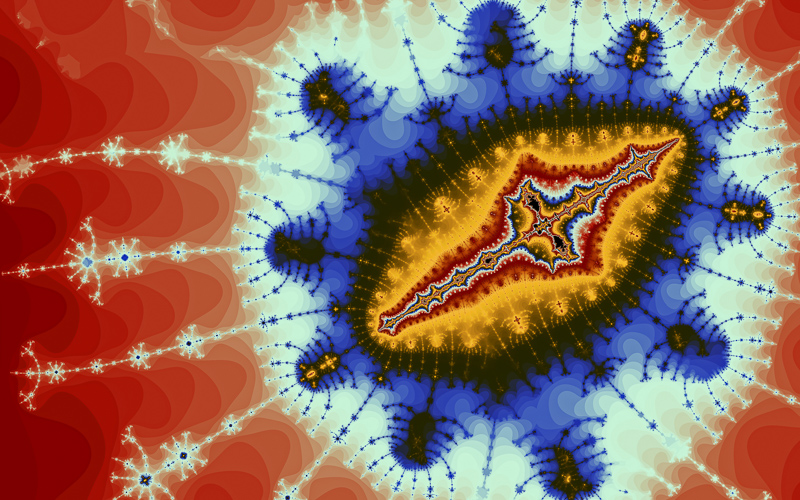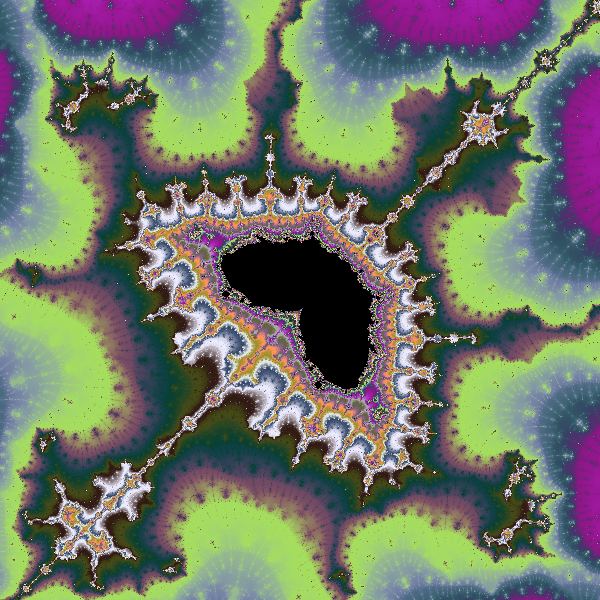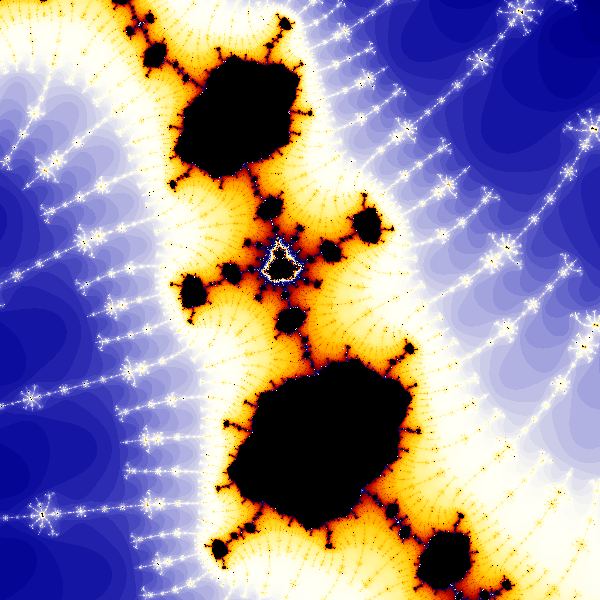I’ve been thinking about “virtualization” in various senses this week.
First of all, I’ve recently read some SF in which some characters are living (or might be living) in a virtual world that might be a subprocess of our own reality. I’m thinking both of Jonathan Lethem’s brilliant novel Chronic City and of Christopher Shay’s great Flurb story “IntheBeginning.”

Secondly, I’ve been listening to my son, Rudy, Jr., talking about how his and Alex Menendez’s internet company, Monkeybrains, can set up virtual machines for their clients to use as their “servers.” There’s a company called VMware that makes a business of selling virtualization tools.
So you might have two, or five, or more people using one and the same hardware box as their server, but with very little chance of interaction between their virtual machines. Ideally, there’d be no chance of seepage among the virtual machines, but in the real world, there’s always a hack. Rudy and Alex, as “Gods of the Cthonic Multiverse,” can certainly move information from one virtual machine to the other.

Trying to get my old free software programs to run in Windows 7, I discovered that I could download some free VM-style ware from Microsoft that pops up a window that’s running a virtual machine whose operating system is the older platform of Windows XP. And Cellab runs okay in there, and Boppers runs, kind of—except that it crashes a lot. And Chaos doesn’t run at all.
There are two odd things about depending on virtual machines to replicate past conditions. For one, there will inevitably come a time when more layers are necessary. Like in ten years, you might need to run Quibix 13, which runs a virtual machine with Windows 10, which runs a VM with Windows 7, which runs a virtual machine with Windows XP, which runs your legacy program.

[Drawn with Ultra Fractal using latest online rvr.upr params RudyGuadalupe]
And the second odd thing is that the simulations will be imperfect. So get glitches that are kind of like supernatural phenomena. A patch of fractal fuzz, a ripple in the wall, a friend who explodes into angular scraps of computer-graphics “fnoor.”
It might be nice to science-fictionalize a situation where someone is living amid multiple layers of VMs—with crashes and glitches. Of course this theme has been treated before, it’s all been done before, but there’s always the hope of doing it with a little more intelligence and soul.
One path out of the VM stack is to meta-virtualize your ware. That is, you “port” it. You abandon the old shell of code, and excise the soul, the core algorithm, and install that in a new body. That’s what I ended up doing with Chaos last week. I ported my favorite fractal, the Rudy Set, from the moribund Chaos ware into the vigorous younger program Ultra Fractal.

Looked at in another sense when you build a house, you’re making a virtual world for yourself. A place where it’s warm and dry and the bugs and dogs can’t come in. A beaver dam is a virtual world, and so is an anthill.
When my old pal Peter Lamborn Wilson, a.k.a. Hakim Bey, writes about congenial gatherings as “Temporal Autonomous Zones,” he’s writing about virtualization—see his online TAZ article. Sometimes you manage to fall into a scene that’s out of this world. An alternate world to live in, an all-meat VR.
The use of the word “virtual” seems jarring in a physical context, as we think of virtuality as wedded to the notion of immaterial software. But in some sense, matter is a kind of software made up of quantum computations, so lets do go ahead and say that, for instance, a picnic blanket creates a virtual world emulation of a living-room rug.
I’m always trying to break away from the received idea that we need computers for interesting things. Post-chip computation was a big theme in my novels Postsingular and Hylozoic, not that this feature of the books was widely remarked upon. I see chips as a passing fad, like mankind’s earlier obsessions with clockwork, with radiation, or with electricity, or with chemistry/alchemy. Like I always say, a rock is a computer. He that hath ears let him hear.
These days, with no particular writing project in mind, more and more things are spontaneously taking on the look of SF stories. It’s how I see the world, particularly when I don’t have any particular goals in mind.

The other day, I was watching a DVD of a concert movie from 1964, The T.A.M.I. Show , with a very wide range of acts, including, near the end, James Brown followed by the Rolling Stones.
I like and respect the idea of James Brown, but his shows have never actually done much for me—not even when I saw him live at the Louisville State Fairgrounds in 1962, oh my brothers. It’s exciting to see someone acting so weird but, for my taste, Brown was too inner-directed. I always had a sense that he doesn’t actually see the audience. This said, I recognize that many people, such as Thom Metzger, think he’s great—see Metzger’s historically weird 1991 novel Shock Totem (today available for $1.57 on e-Bay) about a guy addicted to shock treatment and James Brown.
The young Mick Jagger and his band follow James Brown in the T.A.M.I. movie, and I’d thought I’d see a similarity in their dance styles. Surely the older man was a kind of role model for the younger. Certainly their shoes are similar. But the Mick of 1964’s dance moves are lackadaisical, quasi-ironic, more like sketches of things he might do. Meta-dance. He’s like the Ultra Fractal port of the Chaos version of the Cubic Mandelbrot set. At the time, many thought Mick inferior to James, but he was in fact doing something different. He was using a new operating system.

What impresses me the most in this performance Mick’s eyes—he’s so alert, watching the audience, the other band members, continually aware of his surroundings, although at certain points he too goes into the chanting trance of the singer.
In one cross-stage shot I could see the big-mama Electronovision cameras they were using to simulcast this concert to movie theaters—as well as to record it for posterity. And here, again, I had an SF feeling. The trope of the new transmission device. For 3D, or maybe for feelies, or telepathy, or matter transmission. But not exactly those old things…something more…
I’d like to go to that 1964 T. A. M. I. concert. Suppose we assume that time-travel is impossible. So then, the only way to go to the show is to virtualize the Santa Monica Civic Auditorium of 1964, and worm into that VR. Assume that I want the musicians and the go-go dancers to look exactly like in the film. And maybe I’ll go ahead and have it be in silvery shades of black and white. How do I get there?

[Drawn with Ultra Fractal using latest online rvr.upr params RudyJellyfish]
The traditional way is to plug wires into my brain and jack me into a computer simulation. But—for reasons I’ve discussed before on this blog—I tend to think computer-based VR is never going to be all that convincing. The simulation should be in some sense physical, analog, perhaps based on quantum-computers, like the pocket-universe VRs that Christopher Shea talks about in “IntheBeginning.”
If you’re going physical, there’s no reason to dick around with corny wires in your brain. Make a damned tunnel to a bubble world. That’s the way to do it. I’m going there now. Maybe I’ll catch a buzz with Mick and Terri Garr—she’s the go-go dancer throwing her head around and then doing zombie-moves right behind Chuck Berry.

[Drawn with Ultra Fractal using latest online rvr.upr params RudyStarBranch]
Mick will have, of all people, the plain-jane songstress Leslie Gore on his arm. And we four will bop down to the beach and catch a ride on a chrome-gray UFO. We’ll ride the virtualization into the far future—all the way to 2010.









April 5th, 2010 at 8:16 am
I should have mentioned “True Names,” a 2008 novella by Benjamin Rosenbaum and Cory Doctorow which is in fact based on the premise of competing layers of VR. You can find “True Names” either online or in print in Lou Anders’ Fast Forward 2 anthology from Pyr. Benjamin and Cory’s title is a deliberate riff on Vernon Vinge’s seminal 1981 cyberspace VR story with the same name.
April 7th, 2010 at 12:11 am
Loved loved loved Chronic City.
April 7th, 2010 at 1:13 pm
“there will inevitably come a time when more layers are necessary. Like in ten years, you might need to run Quibix 13, which runs a virtual machine with Windows 10, which runs a VM with Windows 7, which runs a virtual machine with Windows XP, which runs your legacy program.”
I kinda disagree with that. A single VM hypervisor that can emulate multiple different types of hardware architectures (x86, PowerPC, etc) could exist. If in the year 2020 you want to use Windows 3.11 you just start up the hypervisor, select “Create new VM” and under architecture click the i386 radio button, then point it to the Windows 3.11 install disk image and away you go. If in the year 2020 you want to use Quibix 13 you just start up the hypervisor, select “Create new VM” and under architecture click the QuantumComp radio button, then point it to the Quibix 13 install disk image and away you go. No need for extra layers on top of layers. You just need a single hypervisor that supports multiple architectures.
FWIW, I work with VMWare ESX and the Citrix Xen hypervisor for a living so I know a thing or two about virtualization. I’m not trying to sound like Smarty McSmartyPants or anything, I just don’t see a day when more layers are needed on top of one another like you wrote.
April 7th, 2010 at 3:08 pm
Thanks for the input, Jad. Nice word, “hypervisor.” Given the amount of cruft and software orphans that I’ve seen in the computer world, I kind of doubt there will be a clean long-term solution of the kind you imagine.
I’m guessing that at some point the platform that runs a given hypervisor becomes obsolete, and eventually nobody is bothering to upgrade that particular hypervisor…and the newer hypervisors don’t want to be bothered with, like, Windows 3.11. So you end up having to emulate the platform that ran your old hypervisor.
April 8th, 2010 at 10:27 am
Your right Rudy. After making the post I thought about it and realized that I had actually lived through the an experience similar to the scenario you describe.
I needed DOS running in a VM and the DOS VM had to have network access. So I created a DOS VM under VMWare ESX server. The DOS VM was working fine but I could not get networking to work. I needed another way of doing it where networking would work.
So I ended up installing Windows XP in a VM on VMWare ESX server and then installing Microsoft Virtual PC virtualization software on the Windows XP VM and then installed DOS in a VM running in Virtual PC in the Windows XP VM running on VMWare ESX. So it looked like this:
Bare Metal Server > VMWare ESX Hypervisor > Windows XP VM > Virtual PC > DOS VM
April 11th, 2010 at 12:47 am
Hey, I appreciate the shout-out, and I wanted to mention that, in the context of our “True Names”, this is the ideology of one of the characters, Demiurge, who spreads throughout the galaxy armed garrisons (running their intelligences in a virtual-world fashion) with the aim of preserving as much of the non-virtualized world as possible from clear-cutting extropian predators. It seems to me that those who would reduce the world to computronium should be honest that the interesting part of the exercise is not what they intend to recreate, but what they intend to excise — all the things they don’t like about RR — which is to say, all the things they don’t like about the universe not being entirely subject to their will. I suspect deathless utopias of being lifeless; “only in silence the word, only in dark the light”, as Le Guin says. On the other hand I suspect my own suspicion of being that of a curmudgeon who accepts the death-taming tools we have so far (agriculture, money, antibiotics) while fearing new ones….
April 20th, 2010 at 4:15 pm
You could imagine a story in which the universe was a computer with multiple seperate VMs and there was movement of information between them, creating a situation like that of Neal Stephenson’s Anathem.
July 9th, 2010 at 8:35 pm
i just tried a google search for your ware series and cannot find hardware for sale or referenced in a meaningful light. i would love if you would republish the series in a single collection so my son could read it. i used to own them, but due to constant relocations ive lost track of many possessions. thanks for writing.
July 10th, 2010 at 6:22 am
Knowless, there is no HARDWARE novel by me. The newly issued WARE TETRALOGY collects all four of my novels, SOFTWARE, WETWARE, FREEWARE, and REALWARE. You can download a free ebook version of this, or find links to the trade paperback edition on http://www.rudyrucker.com/wares.
September 20th, 2010 at 1:15 pm
I just saw on BoingBoing a virtual machine created by taking a 6502 CPU out of its package, scanning all its layers, putting them in Javascript (by hand, visually) and creating a visual simulation that lets you see what every line and gate is doing in the computer as it runs whatever machine code you type in, at up to 25Hz. (Google “Visual 6502” project)
If we are running in a virtual machine (or any sort, but even more so on a VM) we should expect to see glitches in the emulation. The best repository of 1st hand accounts of such possible glitches I have found is Cynthia Larson’s site “Realityshifters”, whose “your stories” section has around 400 modern first-hand accounts of “reality shifts”, which are mostly disappearing / appearing / reappearing events including all sorts of small objects (especially jewelery), money, food, stores, buildings, trees, sculptures, landmarks, signs, doors, cars, trucks, trains, people, crowds, obituaries, animals, medical conditions, house damages, time, distance, mountain ranges, towns, movie dialog, computer command syntax, electronic faults, electrical repairs, and many others. There are also some more odd stories of short-range teleportation through obstacles, unaccountable velocity and acceleration changes (e.g. falling slowly), time shifts, and various other observations of extreme discrepancies. This includes about two dozen accounts of doppelgangers or similar.
You wrote:
“The simulation should be in some sense physical, analog, perhaps based on quantum-computers, like the pocket-universe VRs that Christopher Shea talks about in “IntheBeginning.”
If you’re going physical, there’s no reason to dick around with corny wires in your brain. Make a damned tunnel to a bubble world. That’s the way to do it. I’m going there now. ”
There is already some promising research in neural interface using infrared lasers. They apparently work better than wires and are being applied to cochlear implants. What if entangled photons were used?
There is also evidence based on hard thermodynamic reasoning that neural impulses cannot be primarily electrical but must be acoustic (myelin acting like speaking-tubes, sol-gel cytoplamic transitions in the pulse maintaining the soliton and allowing dissipation-free transmission, the bulge of the axonal membrane in the pulse making the voltage mostly through capacitive effects, and perhaps a mechanical resonance interaction with the microtubules in the cytoskeleton, which may even be a quantum mechanical phonon-resonant link between the quantum-mechanical electron-based tubulin conformational changes proposed by Hameroff and neural pulse trains).
Another promising area of research uses ultrasound to achieve remote neural stimulation. The effects on quantum-dot tagged neural cell cultures are dramatic. Research on in vivo applications is continuing with ultrasonic phased arrays creating sonic holograms in the brain. On a less sophisticated and lower-frequency level, electrically based neural entrainment devices have relatively subtle effects compared to vibrating the skull directly with chant or mechanical means. A soft tree-like structure such as a brain has rich and complex low-frequency resonance spectra in 7 or 8 spatial dimensions (scalar(?), x, y, z, xy, xz, zy, xyz).